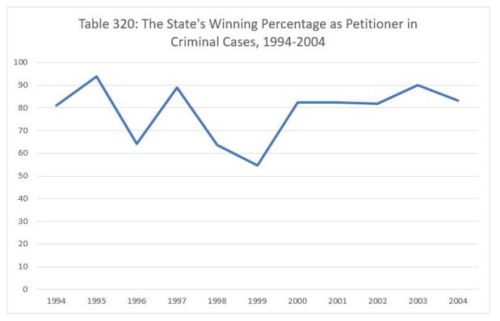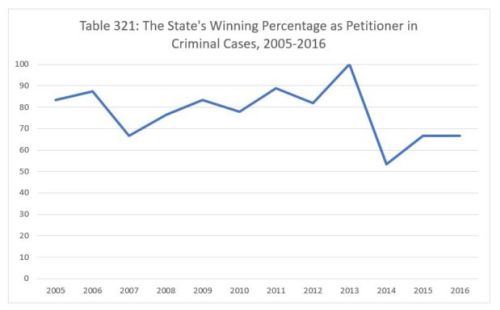Yesterday, we reviewed the year-by-year data on the State's appearances as appellant and respondent in criminal cases from 1994 to 2016. Today, we review the State's winning percentage in each role.
The State won 80.95% of its cases as petition in 1994, 93.75% in 1995, 64.29% in 1996 and 88.89% in 1997. The State won 63.64% in 1998, 54.55% in 1999, 82.35% each in 2000 and 2001, 81.82% in 2002, 90% in 2003 and 83.33% in 2004.

The State's winning percentage remained relatively high for the ten years that followed. The State won 83.33% of its cases as petitioner in 2005, 87.5% in 2006, two-thirds in 2007, 76.47% in 2008, 83.33% in 2009, 77.78% in 2010, 88.89% in 2011 and 81.82% in 2012. The State won all its cases as appellant in 2013, but only 53.33% in 2014 and two-thirds in 2015 and 2016.

We report the State's winning percentage as Respondent in criminal cases from 1994 to 2004 in Table 322. In 1994, the State won 85% of its cases as respondent. The State won 79.31% of its cases in 1995, 73.08% in 1996, 72% in 1997 and 78.79% in 1998. The State won only 60% in 1999, but the State's winning percentage returned to trend thereafter: 81.58% in 2000, 78.95% in 2001, 71.43% in 2002, 78.26% in 2003 and 72.22% in 2004.

The State continued to win an average of about three-quarters of its cases as respondent from 2005 to 2013. The State won 79.07% of tis cases in 2005, 64.86% in 2006, 78.72% in 2007, 79.59% in 2008, 79.17% in 2009, 77.78% in 2010, 80.95% in 2011, 72.73% in 2012 and 74.29% in 2013.
In the years since, the State's winning percentage as respondent has dropped substantially. The Court won only 58.54% of its cases as respondent in 2014, 53.13% in 2015 and 46.51% in 2016.

Join us back here next Thursday as we turn our attention to another issue in the Court's decision making.
The content of this article is intended to provide a general guide to the subject matter. Specialist advice should be sought about your specific circumstances.

